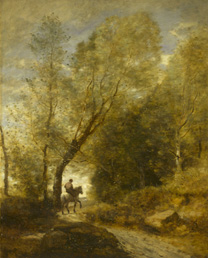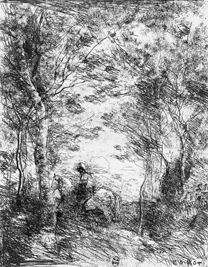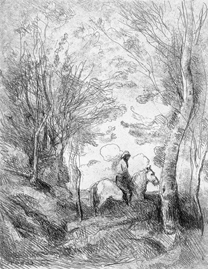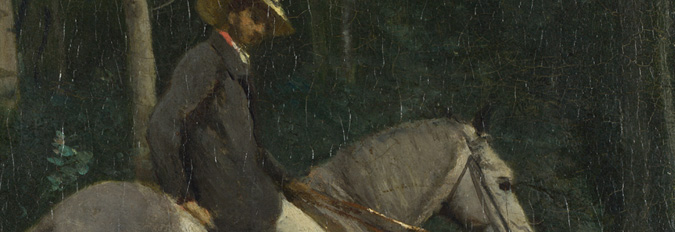Related paintings
This equestrian portrait is unique in Corot’s oeuvre but can be linked to other pictures painted much later in his life. In 1872 he painted Forest at Coubron (Washington, National Gallery of Art; fig. 6), which shows a horse and rider riding off into the distance along a wooded path.6

© Board of Trustees, National Gallery of Art, Washington, DC
Widener Collection (1942.9.12)
Unlike NG 3816, however, the horse and rider are set against a clearing, so that they are silhouetted against the sky. Also in around 1872 Corot painted a portrait of the children of G. Rodrigues-Henriquez in their father’s property, the Parc des Lions at Port-Marly where Corot stayed in August 1872, The Promenade in the Parc des Lions at Port-Marly (R2127) (Madrid, Museo Thyssen-Bornemisza; fig. 7), which shows the same concern with figures, one on a donkey, the other in a light dress, against dark trees, and the light trunks of silver birches against dark forest.7
The dating is of some interest if the painting is compared with two clichés-verre of around 1854: 'The Little Horseman in the Wood (Le Petit Chevalier)' (fig. 8) of January 1854, in which the rider and horse face in the opposite direction from Monsieur Pivot and 'The Large Horseman in the Wood (Le Grand Chevalier)' (fig. 9) of around 1854, in which the rider faces in the same direction. Although the figure is not Monsieur Pivot himself, and the horse is set against a gap in the woods, the overall composition, framed by curving silver birch trunks, is closely related. The figure on the horse is also closely related in stance to Monsieur Pivot, particularly in 'The Large Horseman'.

© Bibliothèque Nationale de France, Paris

The gap in the trees can be explained by the fact that when working with outline only, and in monochrome, it would have been difficult for Corot to set the rider against a mass of foliage. This gap is repeated in the later Forest at Coubron but the position of the horse and rider in the clichés-verre is much more closely related to Monsieur Pivot.
It is probable that these clichés-verre were inspired by his painting of Pivot on horseback. Both Delteil and Melot refer in their catalogues of prints to a painting of the same subject, but are not more specific. It is possible that the painting was lost, or is the above-mentioned Forest at Coubron or this present work.8 Corot wrote to Constant Dutilleux about the print on 23 January 1854: ‘I would ask you, if M. Cuvelier has not sent off the box, to send me by the same post, or later, if it has gone, three proofs of the light etching with the man on horseback which I like so much…’9

